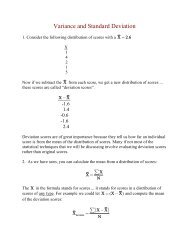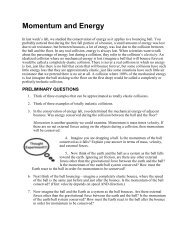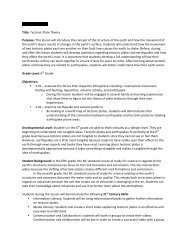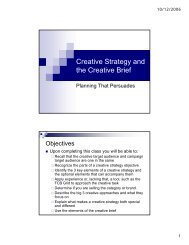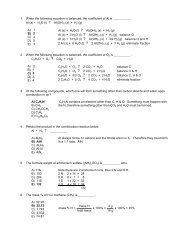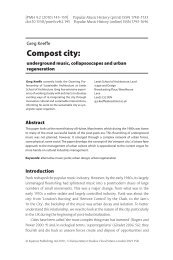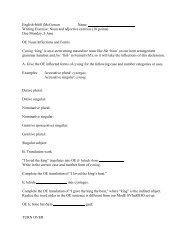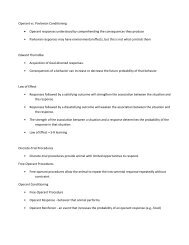The Role of Evaluative Conditioning in Attitude Formation
The Role of Evaluative Conditioning in Attitude Formation
The Role of Evaluative Conditioning in Attitude Formation
Create successful ePaper yourself
Turn your PDF publications into a flip-book with our unique Google optimized e-Paper software.
<strong>The</strong> <strong>Role</strong> <strong>of</strong> <strong>Evaluative</strong> <strong>Condition<strong>in</strong>g</strong> <strong>in</strong><br />
<strong>Attitude</strong> <strong>Formation</strong><br />
Current Directions <strong>in</strong> Psychological<br />
Science<br />
20(3) 192-196<br />
ª <strong>The</strong> Author(s) 2011<br />
Repr<strong>in</strong>ts and permission:<br />
sagepub.com/journalsPermissions.nav<br />
DOI: 10.1177/0963721411408771<br />
http://cdps.sagepub.com<br />
Eva Walther, Rebecca Weil, and Jessica Düs<strong>in</strong>g<br />
University <strong>of</strong> Trier<br />
Abstract<br />
In this article, we address how attitudes are acquired. We present evaluative condition<strong>in</strong>g (EC) as an explanation for attitude<br />
formation and attitude change. EC refers to changes <strong>in</strong> lik<strong>in</strong>g due to pair<strong>in</strong>gs <strong>of</strong> affectively mean<strong>in</strong>gful and neutral stimuli. We<br />
discuss four different theoretical accounts <strong>of</strong> EC and outl<strong>in</strong>e current issues and avenues for future research.<br />
Keywords<br />
evaluative condition<strong>in</strong>g, attitudes, awareness<br />
‘‘Perhaps no s<strong>in</strong>gle concept with<strong>in</strong> the whole realm <strong>of</strong> social<br />
psychology occupies a more nearly central position than that<br />
<strong>of</strong> attitudes.’’ As late-break<strong>in</strong>g as this quote might appear to<br />
contemporary attitude researchers, it was already written <strong>in</strong><br />
1937 by Murphy, Murphy, and Newcomb (1937, p. 889) <strong>in</strong> their<br />
famous book on experimental social psychology. Apparently,<br />
social psychologists have always been fasc<strong>in</strong>ated with attitude<br />
research. One reason for this special role <strong>of</strong> attitudes is the<br />
important <strong>in</strong>fluence they have on guid<strong>in</strong>g our behavior:<br />
We approach people we like and we avoid people we dislike.<br />
We help to break <strong>in</strong> a likeable new colleague and we freely<br />
ignore the e-mails <strong>of</strong> a nasty colleague. However, it appears that<br />
there are strong <strong>in</strong>ter<strong>in</strong>dividual differences <strong>in</strong> preferences, likes,<br />
and dislikes. Although we certa<strong>in</strong>ly dislike the nasty colleague,<br />
there are <strong>in</strong>deed some people <strong>in</strong> the company who appear to like<br />
her. Fac<strong>in</strong>g these differences, the question rema<strong>in</strong>s: How are<br />
<strong>in</strong>dividual attitudes acquired<br />
One experimental answer to this question comes from<br />
evaluative condition<strong>in</strong>g (EC) research (for reviews, see De<br />
Houwer, Thomas, & Baeyens, 2001; H<strong>of</strong>mann, De Houwer,<br />
Perug<strong>in</strong>i, Baeyens, & Crombez, 2010; Walther, Nagengast, &<br />
Trasselli, 2005). EC refers to changes <strong>in</strong> lik<strong>in</strong>g or dislik<strong>in</strong>g<br />
that are due to the pair<strong>in</strong>g <strong>of</strong> stimuli (De Houwer, 2007). In a<br />
prototypical EC study, a neutral picture <strong>of</strong> a human face<br />
(conditioned stimulus; CS) is repeatedly presented with a liked<br />
or disliked human face (unconditioned stimulus; US). <strong>The</strong> common<br />
result is a substantial shift <strong>in</strong> the valence <strong>of</strong> the formerly<br />
neutral CS such that it becomes evaluatively similar to the US<br />
(see Fig. 1). Because the formation and change <strong>of</strong> lik<strong>in</strong>g are the<br />
core elements <strong>of</strong> attitude research, it is no wonder that EC has<br />
received a lot <strong>of</strong> attention <strong>in</strong> this area.<br />
Accord<strong>in</strong>g to the EC account, we start to like a new<br />
colleague because she was accompanied by positive stimuli<br />
<strong>in</strong> the first place. Thus, the mere co-occurrence <strong>of</strong> a neutral<br />
person and a (dis)liked event is sufficient for one to form<br />
an attitude toward the neutral person. One <strong>in</strong>terest<strong>in</strong>g aspect<br />
<strong>of</strong> EC is that evaluative conditioned attitudes, once<br />
formed, appear to be resistant to ext<strong>in</strong>ction. Unlike conditioned<br />
reactions that are acquired <strong>in</strong> a standard classical condition<strong>in</strong>g<br />
paradigm, evaluative conditioned attitudes do not<br />
disappear when the US is no longer present. For <strong>in</strong>stance,<br />
if an eyebl<strong>in</strong>k reaction toward a tone that was previously<br />
paired with an airpuff is acquired, the reaction degrades when<br />
the airpuff is not applied anymore. However, an evaluative<br />
conditioned attitude seems to be more robust than reactions<br />
<strong>in</strong> classical condition<strong>in</strong>g even when the orig<strong>in</strong>al source <strong>of</strong><br />
evaluation is long gone. Another feature <strong>of</strong> EC is its <strong>in</strong>dependence<br />
<strong>of</strong> CS–US cont<strong>in</strong>gency (i.e., correlation), which suggests<br />
that predictability <strong>of</strong> the US from the appearance <strong>of</strong><br />
the CS is not a pr<strong>in</strong>cipal component <strong>in</strong> the EC learn<strong>in</strong>g<br />
process. However, the most debated topic <strong>in</strong> this area is the<br />
question <strong>of</strong> whether EC is dependent on awareness <strong>of</strong> the<br />
correlation between the CS and the US. <strong>The</strong> question <strong>of</strong><br />
whether such awareness is a prerequisite <strong>of</strong> EC is important<br />
because it speaks to the question <strong>of</strong> whether EC should be<br />
considered an automatic or a higher-level cognitive process<br />
Correspond<strong>in</strong>g Author:<br />
Eva Walther, Department <strong>of</strong> Psychology, University <strong>of</strong> Trier, Universitaetsr<strong>in</strong>g<br />
15, 54286 Trier, Germany<br />
E-mail: walther@uni-trier.de<br />
Downloaded from cdp.sagepub.com at APPALACHIAN STATE UNIV on July 28, 2011
Walther et al. 193<br />
1.<br />
CS<br />
CS<br />
Repeated pair<strong>in</strong>g<br />
US<br />
US<br />
+<br />
–<br />
is not universally applicable to the phenomenon <strong>of</strong> conditioned<br />
preferences. Although not explicitly stated by Mart<strong>in</strong> and<br />
Levey (1994), it can be assumed that a certa<strong>in</strong> degree <strong>of</strong> similarity<br />
between CS and US is necessary for the formation <strong>of</strong> a<br />
holistic representation to occur. However, the many <strong>in</strong>stances<br />
<strong>of</strong> cross-modal EC (H<strong>of</strong>mann et al., 2010) suggest that CS–<br />
US similarity is not a necessary precondition for EC effects<br />
to occur. Another issue is that the holistic account is rather<br />
vague with respect to the question <strong>of</strong> how and which characteristics<br />
are fused <strong>in</strong>to a holistic representation.<br />
2.<br />
CS<br />
CS<br />
+<br />
–<br />
US<br />
US<br />
Fig. 1. Schematic illustration <strong>of</strong> evaluative condition<strong>in</strong>g (EC). At the<br />
first stage, the par<strong>in</strong>g <strong>of</strong> a neutral conditioned stimulus (CS) and a<br />
positive unconditioned stimulus (US þ ) or negative unconditioned<br />
stimulus (US – ) is illustrated. Based on this co-occurrence (illustrated<br />
by the two arrows), the CS becomes evaluatively similar to the US<br />
at the second stage.<br />
(Stahl, Unkelbach, & Corneille, 2009). Whereas some<br />
researchers found EC to be <strong>in</strong>dependent <strong>of</strong> awareness <strong>of</strong> the<br />
cont<strong>in</strong>gency <strong>of</strong> the CS and the US (e.g., Walther & Nagengast,<br />
2006), there are studies <strong>in</strong> which only participants aware <strong>of</strong><br />
the cont<strong>in</strong>gencies exhibited EC effects (e.g., Pleyers,<br />
Corneille, Lum<strong>in</strong>et, & Yzerbyt, 2007). This so-called awareness<br />
issue is also reflected <strong>in</strong> the accounts formulated to<br />
expla<strong>in</strong> EC.<br />
Expla<strong>in</strong><strong>in</strong>g <strong>Evaluative</strong> <strong>Condition<strong>in</strong>g</strong>: A Short<br />
Review <strong>of</strong> EC Accounts<br />
<strong>The</strong> holistic account<br />
Over the last several years, a number <strong>of</strong> explanations for EC<br />
have been proposed. Accord<strong>in</strong>g to Mart<strong>in</strong> and Levey (1994),<br />
co-occurrence <strong>of</strong> a US and CS triggers the formation <strong>of</strong> a ‘‘holistic<br />
representation’’ that consists <strong>of</strong> stimulus elements <strong>of</strong> the<br />
CS and the evaluative nature <strong>of</strong> the US. <strong>The</strong> holistic account<br />
can expla<strong>in</strong> the CS’s resistance to ext<strong>in</strong>ction because the CS<br />
itself acquires aspects <strong>of</strong> the US dur<strong>in</strong>g condition<strong>in</strong>g. Moreover,<br />
based on the f<strong>in</strong>d<strong>in</strong>gs that most participants were<br />
unable to recall which CSs had been paired with stimuli,<br />
Mart<strong>in</strong> and Levey concluded that EC does not require awareness<br />
<strong>of</strong> the CS–US cont<strong>in</strong>gency. <strong>The</strong> holistic account, however,<br />
+<br />
–<br />
<strong>The</strong> referential account<br />
Unlike the holistic account, the referential model (Baeyens,<br />
Eelen, Crombez, & van den Bergh, 1992) claims that EC is<br />
based on an associative l<strong>in</strong>k between the CS and the US. If the<br />
CS is presented after condition<strong>in</strong>g, the CS automatically activates<br />
the US representation. However, the referential model<br />
makes no assumption about the learn<strong>in</strong>g process. More specifically,<br />
it is not clear what exactly an association is and how an<br />
association is formed.<br />
<strong>The</strong> implicit misattribution account<br />
<strong>The</strong> implicit misattribution model <strong>of</strong> EC (Jones, Fazio, &<br />
Olsen, 2009) assumes that a CS is liked or disliked to the extent<br />
that people misattribute the valence to the CS, which was actually<br />
elicited by a US presented with it. Because the model proposes<br />
that the evaluative response evoked by a valenced<br />
stimulus is implicitly misattributed to the CS, one could assume<br />
that EC effects only occur for participants who are unaware <strong>of</strong><br />
the CS–US cont<strong>in</strong>gency. What the model cannot expla<strong>in</strong> are<br />
EC effects <strong>in</strong> dissimilar stimuli (i.e., stimuli that belong to different<br />
sensory modalities). Moreover, and most importantly,<br />
the account does not expla<strong>in</strong> why valence is misattributed at all<br />
to the CS <strong>in</strong>stead <strong>of</strong> be<strong>in</strong>g correctly attributed to the US. If the<br />
CS and the US are maximally confusable and, hence, ascription<br />
<strong>of</strong> valence is at the level <strong>of</strong> chance, <strong>in</strong> 50% <strong>of</strong> all cases <strong>in</strong>dividuals<br />
should guess correctly. This, however, would imply that<br />
EC only occurs <strong>in</strong> 50% <strong>of</strong> all learn<strong>in</strong>g cases. A further issue<br />
<strong>of</strong> this account is that attribution is mostly assumed to be a process<br />
that works <strong>in</strong> an all-or-none and not <strong>in</strong> a graduated manner<br />
(Kelley, 1972).<br />
<strong>The</strong> propositional account<br />
This account states that propositional (e.g., rule-based)<br />
knowledge about the CS–US correlation underlies EC. <strong>The</strong><br />
formation <strong>of</strong> these propositions is assumed to be a conscious<br />
and effortful mental process that <strong>in</strong>volves the assignment <strong>of</strong><br />
truth values (Mitchell, De Houwer, & Lovibond, 2009). Based<br />
on this assumption, the propositional account cannot expla<strong>in</strong><br />
results show<strong>in</strong>g that EC is <strong>in</strong>dependent <strong>of</strong> awareness. Moreover,<br />
it is not clear how propositional knowledge is translated<br />
<strong>in</strong>to lik<strong>in</strong>g. A further problem <strong>of</strong> the propositional account is<br />
that EC cannot be dist<strong>in</strong>guished from simple demand effects.<br />
Downloaded from cdp.sagepub.com at APPALACHIAN STATE UNIV on July 28, 2011
194 <strong>Evaluative</strong> <strong>Condition<strong>in</strong>g</strong><br />
People may exhibit evaluative responses toward a CS because<br />
they <strong>in</strong>fer that this stimulus co-occurred with a US (e.g., people<br />
start to dislike an <strong>in</strong>dividual because she is <strong>of</strong>ten <strong>in</strong> company<br />
with another disliked person). However, it could also be<br />
the case that participants simply conform to the experimenters’<br />
<strong>in</strong>tention by <strong>in</strong>ferr<strong>in</strong>g which evaluation might be<br />
expected from them without hav<strong>in</strong>g any authentic affective<br />
reactions. <strong>The</strong> holistic, the referential, and the misattribution<br />
accounts are consistent with EC effects <strong>in</strong> participants unaware<br />
<strong>of</strong> the CS–US cont<strong>in</strong>gency, whereas the propositional<br />
account assumes conscious awareness <strong>of</strong> that cont<strong>in</strong>gency<br />
as a necessary prerequisite for EC effects to occur. One<br />
problem with all <strong>of</strong> these accounts is that they are relatively<br />
silent on the specific processes that underlie the formation<br />
<strong>of</strong> attitudes. If anyth<strong>in</strong>g, they suggest that different mechanisms<br />
(e.g., attributional, associative, propositional) lead to<br />
phenomena that fit <strong>in</strong>to the def<strong>in</strong>ition <strong>of</strong> EC. Given these different<br />
accounts, however, it might be plausible to assume that<br />
more than one process could be <strong>in</strong>volved <strong>in</strong> the formation <strong>of</strong><br />
preferences. In fact, there are phenomena like the spread<strong>in</strong>gattitude<br />
effect (Walther, 2002) or US revaluation (Walther,<br />
Gawronski, Blank, & Langer, 2009) that fit well with the<br />
hypothesis that associative mechanisms underlie EC. However,<br />
there are also phenomena like the formation <strong>of</strong> balanced<br />
triads that more likely rely on propositional knowledge<br />
(Gawronski, Walther, & Blank, 2005).<br />
Spread<strong>in</strong>g <strong>Attitude</strong>s, US Revaluation, and the<br />
Balance Pr<strong>in</strong>ciple<br />
Imag<strong>in</strong>e a situation <strong>in</strong> which your mean colleague Monica is<br />
<strong>of</strong>ten <strong>in</strong> the kitchenette when L<strong>in</strong>da is there also. <strong>The</strong>n later,<br />
L<strong>in</strong>da shows Susan, the new secretary, around. Based on this<br />
simple (and presumably accidental) co-occurrence, which<br />
impression would you form <strong>of</strong> L<strong>in</strong>da and Susan Referr<strong>in</strong>g<br />
to L<strong>in</strong>da, the case is simple. Due to her co-occurrence<br />
with mean Monica, form<strong>in</strong>g a negative attitude toward L<strong>in</strong>da<br />
is just an <strong>in</strong>stance <strong>of</strong> EC. But would Susan also be affected by<br />
this negative attitude Accord<strong>in</strong>g to the spread<strong>in</strong>g-attitude<br />
effect (Walther, 2002), the answer is yes. <strong>The</strong> spread<strong>in</strong>gattitude<br />
effect refers to the phenomenon that an evaluated<br />
stimulus (Monica) may <strong>in</strong>fluence not only the evaluation <strong>of</strong><br />
an event that co-occurs with the stimulus (L<strong>in</strong>da) but also the<br />
evaluation <strong>of</strong> other stimuli that are merely associated with it<br />
(Susan).<br />
A further example <strong>of</strong> an EC effect that is presumably based<br />
on an unconscious transfer <strong>of</strong> valence is the US-revaluation<br />
effect. US revaluation means that subsequent changes <strong>in</strong> the<br />
valence <strong>of</strong> a US after pair<strong>in</strong>g it with a CS also changes the<br />
valence<strong>of</strong>theCS.For<strong>in</strong>stance,Walther,Gawronski,Blank,<br />
andLanger(2009)pairedpositive USs with negative <strong>in</strong>formation<br />
and negative USs with positive <strong>in</strong>formation after an <strong>in</strong>itial<br />
condition<strong>in</strong>g phase. This revaluation not only led to a<br />
reversal <strong>in</strong> the valence <strong>of</strong> the US but also changed the affective<br />
quality <strong>of</strong> the preassociated CS <strong>in</strong> the direction <strong>of</strong> the<br />
revaluated US.<br />
<strong>The</strong> fact that spread<strong>in</strong>g-attitude effects <strong>in</strong>crease rather than<br />
decrease when people are distracted dur<strong>in</strong>g the condition<strong>in</strong>g<br />
procedure and the f<strong>in</strong>d<strong>in</strong>gs that people have no memory for<br />
the revaluat<strong>in</strong>g <strong>in</strong>formation <strong>of</strong> the US suggest that the<br />
spread<strong>in</strong>g-attitude effect, as well as US revaluation, are <strong>in</strong>dependent<br />
<strong>of</strong> cont<strong>in</strong>gency awareness. This means that both<br />
effects are consistent with all the above-mentioned EC<br />
accounts except the propositional account. However, there are<br />
also EC phenomena that seem to imply the use <strong>of</strong> propositional<br />
knowledge.<br />
Imag<strong>in</strong>e aga<strong>in</strong> a situation <strong>in</strong> which your mean colleague Monica<br />
is bother<strong>in</strong>g you with how much she hates the new secretary<br />
Susan, who started her job a couple <strong>of</strong> days ago. Imag<strong>in</strong>e you<br />
had not met Susan yet, however, based on the <strong>in</strong>formation you<br />
already have, would you like or dislike her Accord<strong>in</strong>g to mere<br />
associative-process models, you would start to dislike Susan<br />
because she is associated with two negative evaluations: mean<br />
Monica and be<strong>in</strong>g disliked (Gawronski & Bodenhausen,<br />
2006). Thus, associative-process models predict that the negative<br />
valence <strong>of</strong> both the person Monica and her attitude are transferred<br />
to the new colleague Susan, result<strong>in</strong>g <strong>in</strong> a negative attitude<br />
toward her. Conversely, if propositional processes are at work,<br />
the result<strong>in</strong>g attitude toward Susan might be positive. This is<br />
because people are able to form balanced triads based on propositional<br />
reason<strong>in</strong>g (Heider, 1958). Form<strong>in</strong>g a balanced triad<br />
means, for example, that people like <strong>in</strong>dividuals who are disliked<br />
by people they personally dislike. In this example, one would<br />
start to like Susan because she is disliked by mean Monica. <strong>The</strong><br />
formation <strong>of</strong> balanced triads means that <strong>in</strong>dividuals are not<br />
bound to rely on <strong>in</strong>formation as it is presented <strong>in</strong> the environment.<br />
Rather, due to the balance pr<strong>in</strong>ciple, people may overcome,<br />
for <strong>in</strong>stance, the negativity out there (e.g., mean Monica<br />
and her negative attitude) and form a positive attitude <strong>in</strong>stead.<br />
Conclud<strong>in</strong>g Remarks<br />
Despite the long tradition <strong>in</strong> learn<strong>in</strong>g theory to expla<strong>in</strong> condition<strong>in</strong>g<br />
effects by means <strong>of</strong> associative models, propositional<br />
accounts have recently become very popular <strong>in</strong> this area (De<br />
Houwer, 2009; Mitchell et al., 2009). However, the question<br />
rema<strong>in</strong>s whether associative and propositional accounts are<br />
mutually exclusive. Generally, an association merely refers to<br />
a connection between events <strong>in</strong> memory (Carr, 1930). Thus, the<br />
term association is descriptive <strong>in</strong> nature and refers neither to<br />
the substance <strong>of</strong> this l<strong>in</strong>k nor to a particular theory <strong>of</strong> how this<br />
l<strong>in</strong>k is formed or ma<strong>in</strong>ta<strong>in</strong>ed. Although most associative<br />
approaches implicitly assume that the l<strong>in</strong>k <strong>in</strong> memory is formed<br />
automatically, the question <strong>of</strong> how associations are formed and<br />
how they <strong>in</strong>fluence the organism’s behavior has so far been<br />
<strong>in</strong>sufficiently addressed <strong>in</strong> learn<strong>in</strong>g theory. From this perspective,<br />
a dist<strong>in</strong>ction between, for <strong>in</strong>stance, associative and propositional<br />
learn<strong>in</strong>g is mislead<strong>in</strong>g. This is because associative<br />
learn<strong>in</strong>g is <strong>in</strong>herent <strong>in</strong> propositional learn<strong>in</strong>g as long as we<br />
assume that a l<strong>in</strong>k (an association) between the mental representations<br />
has been formed (but see De Houwer, 2009, for a<br />
different perspective).<br />
Downloaded from cdp.sagepub.com at APPALACHIAN STATE UNIV on July 28, 2011
Walther et al. 195<br />
Based on the f<strong>in</strong>d<strong>in</strong>g that EC effects for participants aware<br />
and unaware <strong>of</strong> the CS–US cont<strong>in</strong>gency exist, one conclusion<br />
might be that EC effects can be the result <strong>of</strong> different<br />
processes. An alternative conclusion, however, could be that<br />
a s<strong>in</strong>gle cognitive process underlies all types <strong>of</strong> (aware and<br />
unaware) EC effects (Kruglanski, Erb, Pierro, Mannetti, &<br />
Chun, 2006). Whether awareness is necessary or not to produce<br />
EC effects may depend on the different parameters<br />
given <strong>in</strong> the learn<strong>in</strong>g situation. For <strong>in</strong>stance, it could be<br />
assumed that cognitive resources (e.g., time pressure or load),<br />
task demand (e.g., number <strong>of</strong> trials, <strong>in</strong>terstimulus <strong>in</strong>terval),<br />
and motivation parameters (e.g., salience or <strong>in</strong>tensity <strong>of</strong> the<br />
US) play important roles <strong>in</strong> attitude formation. Based on<br />
this assumption, the particular composition <strong>of</strong> parameters<br />
given <strong>in</strong> the respective context, rather than different processes,<br />
may constitute outcome differences such as EC<br />
effects <strong>in</strong> aware or unaware participants. Thus, differences<br />
on the phenomenological level can be considered as an epiphenomenon<br />
<strong>of</strong> the very same learn<strong>in</strong>g process. To be sure,<br />
these rules might be different, reach<strong>in</strong>g from primitive<br />
if–then heuristics (e.g., if I feel positively <strong>in</strong> the context <strong>of</strong><br />
this stimulus, I like it) to more sophisticated cont<strong>in</strong>gencybased<br />
rules <strong>of</strong> prediction.<br />
Depend<strong>in</strong>g on certa<strong>in</strong> parameters like motivation, the if–<br />
then rule might therefore vary from very basic similarity heuristics<br />
to more sophisticated causal-<strong>in</strong>ference rules. Apply<strong>in</strong>g<br />
this logic to the awareness issues, it is not implausible to<br />
assume that, for <strong>in</strong>stance, the relevance (<strong>in</strong>tensity) <strong>of</strong> the US<br />
determ<strong>in</strong>es the degree <strong>of</strong> awareness. Cont<strong>in</strong>gency awareness<br />
<strong>in</strong> turn might be necessary <strong>in</strong> order to predict the US. Thus,<br />
with <strong>in</strong>creas<strong>in</strong>g <strong>in</strong>tensity <strong>of</strong> the US, the <strong>in</strong>fluence <strong>of</strong> awareness<br />
on condition<strong>in</strong>g might <strong>in</strong>crease. Admittedly, these possibilities<br />
are speculative <strong>in</strong> nature. However, they can be put to empirical<br />
test by experimentally manipulat<strong>in</strong>g learn<strong>in</strong>g parameters <strong>in</strong> EC<br />
studies. Support for a s<strong>in</strong>gle rule-based process that underlies<br />
all types <strong>of</strong> condition<strong>in</strong>g has come from recent research<br />
show<strong>in</strong>g causal reason<strong>in</strong>g <strong>in</strong> rats (Blaisdell, Sawa, Leis<strong>in</strong>g, &<br />
Waldmann, 2006). This result not only challenges the view<br />
<strong>of</strong> causal reason<strong>in</strong>g as the key operation that differentiates<br />
humans from other animals but also supports the approach<br />
that the same process underlies all k<strong>in</strong>ds <strong>of</strong> learn<strong>in</strong>g.<br />
Recommended Read<strong>in</strong>g<br />
De Houwer, J. (2007). (See References). An account that tries to<br />
clarify the underly<strong>in</strong>g processes <strong>of</strong> evaluative condition<strong>in</strong>g.<br />
De Houwer, J., Thomas, S., & Baeyens, F. (2001). (See References).<br />
A summary <strong>of</strong> literature and evidence with respect to recent evaluative<br />
condition research.<br />
H<strong>of</strong>mann, W., De Houwer, J., Perug<strong>in</strong>i, M., Baeyens, F., & Crombez,<br />
G. (2010). (See References). This paper provides a meta-analysis<br />
<strong>of</strong> evaluative-condition<strong>in</strong>g research.<br />
Walther, E., & Langer, T. (2008). <strong>Attitude</strong> formation and change<br />
through association: An evaluative condition<strong>in</strong>g account. In<br />
R. Prisl<strong>in</strong> & W.B. Crano (Eds.), <strong>Attitude</strong>s and attitude change<br />
(pp. 87–109). New York, NY: Psychology Press. This paper<br />
provides an overview <strong>of</strong> research and theories concern<strong>in</strong>g<br />
evaluative condition<strong>in</strong>g.<br />
Declaration <strong>of</strong> Conflict<strong>in</strong>g Interests<br />
<strong>The</strong> authors declared no potential conflicts <strong>of</strong> <strong>in</strong>terest with respect to<br />
the research, authorship, and/or publication <strong>of</strong> this article.<br />
References<br />
Baeyens, F., Eelen, P., Crombez, G., & van den Bergh, O. (1992).<br />
Human evaluative condition<strong>in</strong>g: Acquisition trials, presentation<br />
schedule, evaluative style and cont<strong>in</strong>gency awareness. Behaviour<br />
Research and <strong>The</strong>rapy, 30, 133–142.<br />
Blaisdell, A.P., Sawa, K., Leis<strong>in</strong>g, K.J., & Waldmann, M.R. (2006).<br />
Causal reason<strong>in</strong>g <strong>in</strong> rats. Science, 311, 1020–1022.<br />
Carr, H. (1930). In Functionalism. Psychologies <strong>of</strong> 1930. (pp. 59–78).<br />
Oxford, England: Clark University Press.<br />
De Houwer, J. (2007). A conceptual and theoretical analysis <strong>of</strong><br />
evaluative condition<strong>in</strong>g. Spanish Journal <strong>of</strong> Psychology, 10,<br />
230–241.<br />
De Houwer, J. (2009). <strong>The</strong> propositional approach to associative<br />
learn<strong>in</strong>g as an alternative for association formation models. Learn<strong>in</strong>g<br />
and Behavior, 37, 1–20.<br />
De Houwer, J., Thomas, S., & Baeyens, F. (2001). Associative learn<strong>in</strong>g<br />
<strong>of</strong> likes and dislikes: A review <strong>of</strong> 25 years <strong>of</strong> research on<br />
human evaluative condition<strong>in</strong>g. Psychological Bullet<strong>in</strong>, 127,<br />
853–869.<br />
Gawronski, B., & Bodenhausen, G.V. (2006). Associative and<br />
propositional processes <strong>in</strong> evaluation: An <strong>in</strong>tegrative review <strong>of</strong><br />
implicit and explicit attitude change. Psychological Bullet<strong>in</strong>,<br />
132, 692–731.<br />
Gawronski, B., Walther, E., & Blank, H. (2005). Cognitive consistency<br />
and the formation <strong>of</strong> <strong>in</strong>terpersonal attitudes: Cognitive balance<br />
affects the encod<strong>in</strong>g <strong>of</strong> social <strong>in</strong>formation. Journal <strong>of</strong><br />
Experimental Social Psychology, 41, 618–626.<br />
Heider, F. (1958). <strong>The</strong> psychology <strong>of</strong> <strong>in</strong>terpersonal relations. New<br />
York, NY: Wiley.<br />
H<strong>of</strong>mann, W., De Houwer, J., Perug<strong>in</strong>i, M., Baeyens, F., &<br />
Crombez, G. (2010). <strong>Evaluative</strong> condition<strong>in</strong>g <strong>in</strong> humans: A metaanalysis.<br />
Psychological Bullet<strong>in</strong>, 136, 390–421.<br />
Jones, C.R., Fazio, R.H., & Olson, M.A. (2009). Implicit misattribution<br />
as a mechanism underly<strong>in</strong>g evaluative condition<strong>in</strong>g. Journal<br />
<strong>of</strong> Personality and Social Psychology, 96, 933–948.<br />
Kelley, H.H. (1972). Causal schemata and the attribution<br />
process. In E.E. Jones, D.E. Kanouse, H.H. Kelley, R.E.<br />
Nisbett, S. Val<strong>in</strong>s, & B. We<strong>in</strong>er (Eds.), Attribution: Perceiv<strong>in</strong>g<br />
the causes <strong>of</strong> behavior. Morristown, NJ: General Learn<strong>in</strong>g<br />
Press.<br />
Kruglanski, A.W., Erb, H.-P., Pierro, A., Mannetti, L., & Chun, W.Y.<br />
(2006). On parametric cont<strong>in</strong>uities <strong>in</strong> the world <strong>of</strong> b<strong>in</strong>ary eitherors.<br />
Psychological Inquiry, 17, 153–165.<br />
Mart<strong>in</strong>, I., & Levey, A.B. (1994). <strong>The</strong> evaluative response:<br />
Primitive but necessary. Behaviour Research and <strong>The</strong>rapy, 32,<br />
301–305.<br />
Downloaded from cdp.sagepub.com at APPALACHIAN STATE UNIV on July 28, 2011
196 <strong>Evaluative</strong> <strong>Condition<strong>in</strong>g</strong><br />
Mitchell, C.J., De Houwer, J., & Lovibond, P.F. (2009). <strong>The</strong><br />
propositional nature <strong>of</strong> human associative learn<strong>in</strong>g. Behavioral<br />
and Bra<strong>in</strong> Sciences, 32, 183–198.<br />
Murphy, G., Murphy, L.B., & Newcomb, T.M. (1937). Experimental<br />
social psychology: An <strong>in</strong>terpretation <strong>of</strong> research upon the socialization<br />
<strong>of</strong> the <strong>in</strong>dividual. New York, NY and London, England:<br />
Harper & Brothers.<br />
Pleyers, G., Corneille, O., Lum<strong>in</strong>et, O., & Yzerbyt, V. (2007).<br />
Aware and (dis)lik<strong>in</strong>g: Item-based analyses reveal that<br />
valence acquisition via evaluative condition<strong>in</strong>g emerges only<br />
when there is cont<strong>in</strong>gency awareness. Journal <strong>of</strong> Experimental<br />
Psychology: Learn<strong>in</strong>g Memory and Cognition, 33,<br />
130–144.<br />
Stahl, C., Unkelbach, C., & Corneille, O. (2009). On the respective<br />
contributions <strong>of</strong> awareness <strong>of</strong> US valence and US identity <strong>in</strong><br />
valence acquisition through evaluative condition<strong>in</strong>g. Journal <strong>of</strong><br />
Personality & Social Psychology, 97, 404–420.<br />
Walther, E. (2002). Guilty by mere association: <strong>Evaluative</strong> condition<strong>in</strong>g<br />
and the spread<strong>in</strong>g attitude effect. Journal <strong>of</strong> Personality and<br />
Social Psychology, 82, 919–934.<br />
Walther, E., Gawronski, B., Blank, H., & Langer, T. (2009). Chang<strong>in</strong>g<br />
likes and dislikes through the back door: <strong>The</strong> US-revaluation<br />
effect. Cognition and Emotion, 23, 889–917.<br />
Walther, E., & Nagengast, B. (2006). <strong>Evaluative</strong> condition<strong>in</strong>g and the<br />
awareness issue: Assess<strong>in</strong>g cont<strong>in</strong>gency awareness with the fourpicture<br />
recognition test. Journal <strong>of</strong> Experimental Psychology: Animal<br />
Behavior Processes, 32, 454–459.<br />
Walther, E., Nagengast, B., & Trasselli, C. (2005). <strong>Evaluative</strong> condition<strong>in</strong>g<br />
<strong>in</strong> social psychology: Facts and speculations. Cognition<br />
and Emotion, 19, 175–196.<br />
Downloaded from cdp.sagepub.com at APPALACHIAN STATE UNIV on July 28, 2011



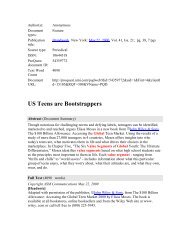

![Graduate Bulletin [PDF] - MFC home page - Appalachian State ...](https://img.yumpu.com/50706615/1/190x245/graduate-bulletin-pdf-mfc-home-page-appalachian-state-.jpg?quality=85)
